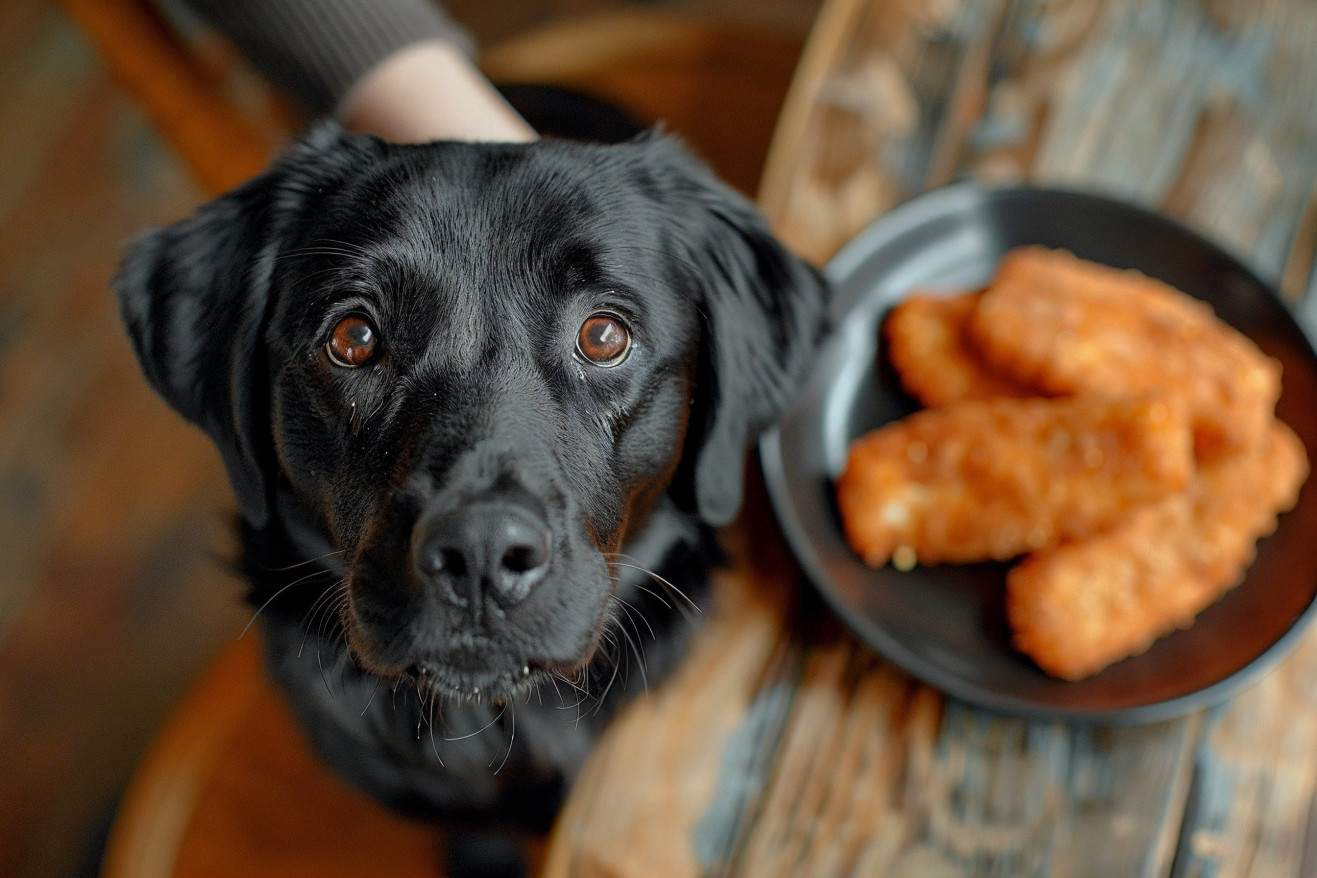Can Dogs Eat Fish Sticks? Nutritional Do’s and Don’ts for Your Pet
22 February 2024 • Updated 21 February 2024

Fish sticks might sound like a delicious option for a quick meal, but can you share them with your dog? While fish sticks are technically safe for dogs to eat, they are not a good idea because of the high sodium content, toxic spices like onion and garlic, and the potential for an upset stomach.
Instead, give your dog a little bit of cooked fish that has been prepared simply, without bones and added ingredients.
This article will use a combination of expert veterinary knowledge and research into the nutritional needs of dogs to look at the specific ingredients in fish sticks and how they impact a dog’s health. We will look at what dogs need in their diets, the benefits and drawbacks of fish, and how the processing and ingredients in fish sticks can help or hurt them.
This research is intended to help you understand how you can best add fish to your dog’s diet in a way that is safe and healthy.
Can dogs eat fish sticks?
Nutritional Requirements and Nutritional Balance for Your Dog’s Diet
Knowing what dogs need in their diet is important for their overall health and longevity. As VCA Animal Hospitals explains, dogs need proteins, fats, carbohydrates, vitamins, minerals, and water in their diet.
To meet a dog’s nutritional needs, it’s important to make sure these things are balanced in a dog’s diet, with a focus on the quality of proteins and fats, the digestibility of carbohydrates, and the amount of minerals and vitamins.
Different life stages require different nutritional needs, with puppies needing more frequent feedings and a diet that supports growth and seniors needing a diet that may be lower in calories and include ingredients that support joint health.
According to PetMD, an unbalanced diet can lead to a number of health problems. For example, feeding dogs a diet that’s high in salt or doesn’t include the necessary nutrients can lead to obesity, deficiencies, or other metabolic disorders. It’s also important for dog owners to make sure their pets always have access to fresh water since it’s so important for a dog’s health.
WebMD explains that the AAFCO has set important standards for determining whether dog food products, including fish sticks, are nutritionally appropriate. These standards ensure that a dog’s food is “complete and balanced,” meaning it includes all of the nutrients a dog needs based on their specific life stage.
As a result, when it comes to determining whether fish sticks are safe for dogs, it’s important to determine whether or not they meet the AAFCO’s nutritional standards for a healthy dog diet.
Nutritional Value of Fish Sticks and Dogs’ Nutritional Needs
While fish sticks might seem like a quick and easy treat for your dog, their nutritional value says otherwise. Fish sticks, which are typically made from white fish like pollock or cod, are highly processed and often flavored with ingredients like onion and garlic powder. According to World Dog Finder, these ingredients, while tasty to humans, are poisonous to dogs and can lead to severe side effects like vomiting and diarrhea.
Pupvine also notes that the high sodium content in fish sticks is worrisome for dog owners and can lead to dehydration and even salt poisoning. The frying process also adds to the problem by adding unhealthy fats that can lead to weight gain and other health issues. In addition, these processed foods are considered ‘empty calories,’ meaning they don’t offer the nutritional value that dogs need to be healthy.
Instead, Purina recommends giving dogs plain fish, which can provide omega-3 fatty acids without the negative impact of seasoning and too much salt. By choosing a simple, boneless, and properly cooked fish, you can give your dog a treat that’s more in line with their nutritional needs.
Processed Dog Foods Can Be Dangerous
Processed foods, like fish sticks, can be dangerous for dogs. A report by PetHelpful explains that the high-temperature processing used to make commercial dog food not only changes the chemical composition of the food but can also reduce the vitamin content and increase the amount of advanced glycation end products (AGEs). These changes can lead to age-related and inflammatory diseases and can be dangerous to dogs in the long term.
Meanwhile, the additives, preservatives, and dyes that are often found in processed dog foods can be even more dangerous. The Naturally Healthy Pets blog by Dr. Judy Morgan notes that unnatural preservatives, including propylene glycol, ethoxyquin, BHA, and BHT, have been linked to cancer in studies.
Meanwhile, an article by DogTime explains that the low-quality ingredients and fillers used in processed dog foods can lead to sensitivities or allergies, digestive issues, and even obesity and diabetes.
On the other hand, whole foods and natural ingredients can have a range of benefits, including better digestion and weight control. So, when you’re thinking about what to feed your dog, it’s best to look for alternative treats that better meet their nutritional needs, like fresh veggies or lean meats. By doing so, you can help ensure that your dog is as healthy as possible and avoid the dangers of processed dog foods.
Reeling in the Benefits: Fish in Your Dog’s Diet
Fish can provide a wealth of benefits when added to your dog’s diet, including a variety of proteins and omega-3 fatty acids that are important for overall health. The American Kennel Club recommends feeding dogs fish like salmon, ocean whitefish, herring, and flounder because they are lower in mercury. These types of fish can help strengthen your dog’s immune system, improve skin and coat health, and even help with inflammation.
The Merck Veterinary Manual notes that fish should be cooked for dogs and that it should not be prepared with any oils or seasonings. In addition, it should be deboned to prevent choking or internal damage.
WebMD recommends that fish be given in moderation; while it can be a healthy addition to your dog’s diet, it should not be used in place of a complete and balanced diet that meets AAFCO guidelines and should not exceed 10 percent of the treat recommendation.
While fish is generally safe for dogs, pet parents should watch for signs of an allergic reaction and consult with their vet before making any major changes to their dog’s diet. If introduced properly, fish that is cooked and prepared correctly can be a healthy and tasty addition to your dog’s diet.
The Best Way to Cook Fish for Your Dog’s Fish Treats
The way fish is cooked can change its nutritional profile, and some cooking methods have a bigger impact than others. A study by Bastías et al., published in PMC, found that cooking methods like steaming and oven baking can help maintain the protein and omega-3 fatty acid content in fish, both of which are important for your dog’s diet.
On the other hand, frying, which is often used to make fish sticks, not only decreases these important nutrients but also increases the calorie count and may introduce harmful substances.
Because of the potential for bacterial contamination in raw fish, it’s important to cook the fish before giving it to your dog. MedCrave online notes that baking and steaming are better cooking methods because they help maintain the nutritional value of the fish, while frying can lead to a loss of valuable omega-3 fatty acids—a point also made by Healthline.
Dog owners who are cooking fish at home should choose to bake or steam the fish to ensure their dog gets the most nutritional value with the least risk. By paying attention to these methods, you can make sure your dog gets a healthy, nutritious treat that will help them stay healthy.
Conclusion: The Last Word on Fish Sticks and Doggy Diet
To sum it up, while dogs will likely find fish sticks to be tasty, they are often packed with salt, spices, and other additives that can be bad for their health. The high sodium levels and the presence of toxic ingredients like onion and garlic powder can lead to dehydration and gastrointestinal distress.
In general, processed foods like fish sticks are high in calories and low in the nutrients that dogs need, which can lead to obesity and other health issues.
A well-balanced diet is important for dogs, and fish that is prepared and served properly can be a good source of protein and omega-3 fatty acids. The way the fish is prepared matters, and fish that is steamed or baked will retain its nutritional value and be safe and beneficial for dogs.
Fish should be an addition to, not a replacement for, a nutritionally complete diet that is formulated to meet a dog’s specific needs based on their life stage and other factors.
Given the complexity of dog nutrition, it’s clear that working with a veterinarian is important to get personalized dietary recommendations for your pet. By being thoughtful about your dog’s diet, you can help ensure that they live a long, healthy, and active life.


